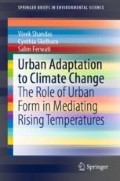Abstract
The rapidly changing climate is a crisis that, at its core, challenges many of the systems that support human habitation in cities, where the majority of people now live. The local effects of our destabilizing climate are most profound through extreme events, and heat waves are the most notorious for killing more people than all other natural disasters combined. In places like Doha, Qatar, where ambient temperatures can reach upward of 50 °C, will, by necessity, be at the forefront of adaptation strategies to improve livability through mediating extreme heat. Even though the region has long considered extreme heat in planning urban development, increasing temperatures require further reformulation of planning and development systems to accommodate new questions relevant to livability. This chapter provides a description of the relationship between rapidly growing urban regions, such as Doha, and the relationship between the built environment and human livability.
Access this chapter
Tax calculation will be finalised at checkout
Purchases are for personal use only
Notes
- 1.
Sherwood, S. C. and Huber, M. (2010) ‘An adaptability limit to climate change due to heat stress’, Proceedings of the National Academy of Sciences, 107(21), p. 9552 LP-9555. https://doi.org/10.1073/pnas.0913352107.
References
Brookings (2015) Navigating uncertainty: Qatar’s response to the global gas boom. Brookings Institution
Carruthers J (2003) Growth at the fringe: the influence of political fragmentation in United States metropolitan areas. Reg Sci 82(4):475–499
Cutter SL (2016) The landscape of disaster resilience indicators in the USA. Nat Hazards 80(2):741–758
Solecki, William & Leichenko, Robin & O’Brien, Karen (2011) Climate change adaptation strategies and disaster risk reduction in cities: Connections, contentions, and synergies. Curr Opin Environ Sustain 3:135–141
Voelkel J, Hellman D, Sakuma R, Shandas V (2018) Assessing vulnerability to urban heat: a study of disproportionate heat exposure and access to refuge by socio-demographic status in Portland, Oregon. Int J Environ Research and Public Health 15(4):640
Author information
Authors and Affiliations
Corresponding author
Rights and permissions
Copyright information
© 2020 The Author(s), under exclusive license to Springer Nature Switzerland AG
About this chapter
Cite this chapter
Shandas, V. (2020). Urban Heat and Livability. In: Urban Adaptation to Climate Change. SpringerBriefs in Environmental Science. Springer, Cham. https://doi.org/10.1007/978-3-030-26586-1_1
Download citation
DOI: https://doi.org/10.1007/978-3-030-26586-1_1
Published:
Publisher Name: Springer, Cham
Print ISBN: 978-3-030-26585-4
Online ISBN: 978-3-030-26586-1
eBook Packages: Earth and Environmental ScienceEarth and Environmental Science (R0)

